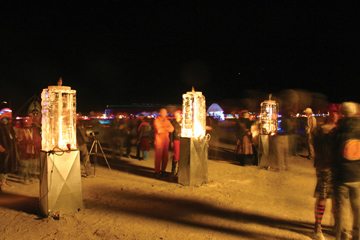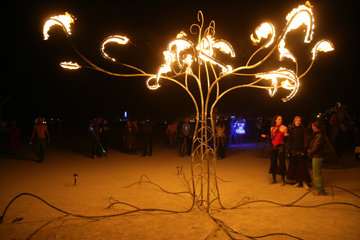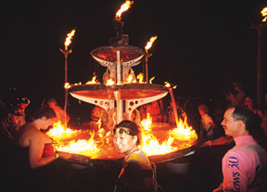| ORDER/SUBSCRIBE SPONSORS CONTACT WHAT'S NEW INDEX/SEARCH HOME | |||||||
Fire Arts of Burning Man: IntroductionA Passion to Burnby Louis M. BrillFire art is like magic. As it has its secrets, there are practitioners who seek out these secrets, exploit them and then put them on a stage to share with audiences. The appeal of fire is primal and all-powerful. Fire calls to us from the beginning of time---some say it helped to create the earth. It calls as a power of change, as it has helped humans to survive by providing warmth, cooked food and, when necessary, a weapon. At Burning Man, fire calls out as one of the most captivating art forms. It is both paintbrush and canvas in the creation of an art form in which fear and fascination mingle. Fire art at Burning Man has a long and cherished history, as discussed by LadyBee, art curator of Burning Man, in the essay following. While fire art in various forms (performance and sacrificial rituals) has deep roots in human history, it is through Burning Man that fire art has become a modern expressive form of sculptural creativity. In the early 1990s, when the first Burning Man sculptures were burned, people would always say, "How could you do that?" "How could you burn something that was so beautiful?" That was exactly the point. Is the beauty of Burning Man in its physical form or in the idea of the totality of whatever the Burning Man sculpture represents? The moment in which the Man burns is all the more transcendental as viewers come to terms with the fiery transformation from its physical existence to a spiritual one. Art Fires the ImaginationLeonardo journal's Fire Arts of Burning Man special section is an opportunity to introduce, categorize, document and discuss some of the great fire art that has flamed and flickered over the years at Burning Man. We can group the fire arts of Burning Man into four categories: Spectacle, Mechanically Controlled Art, Transcendence, and Interactivity. In this issue we highlight work in three of these categories. In cases where works could be placed in two or more categories (for example, while The Voice of Fire and the Fire Vortex are mechanical representations of fire art, they are also interactive forms), we have placed each in the category that most strongly represents the spirit of the work. SpectacleSpectacle works are all about "letting go." Huge art installations are built as things of wonder and then liberated in conflagrations that reduce their forms to ash, smoke and a memory of something that was. The Man, David Best's Temples and Pepe Ozan's Opera Towers are some of the architectural forms that have been burned as spectacular fire art.Mechanically Controlled ArtThis variety displays the conjunction of fire and machine, where propane tanks, hoses, solenoid valves, igniters and uninhibited imagination come together in mechanical fire-art fantasies come true. Here, via any number of mechanical assemblages, artists are able to mold and massage the fire's flames according to their creative inspirations. In this form, fire is harnessed with a variety of mechanized flourishes, such as with Lucy Hosking's Satan's Calliope, Tim Black's The Voice of Fire, Therm's Thermokraken and Exxothermia, Jenne Giles and Paul Cesewski's Lotus-Land, Larry Breed's Chaotick, Dan Ng's Running Man, Dan Das Mann's Faces of the Man, Jack Schroll's El Diablo, the Flaming Lotus Girls' Seven Sisters and in the work of Kal Spelletich's group SEEMEN.
TranscendenceThis is fire art involving intimate contact with fire. All people fear fire. Fear produces powerful emotion, and certainly intimate contact with fire does strange things to a person's psyche. In some cases it is seen as a transcendent liberation, as in the age-old ritual of walking on hot coals and emerging unscathed.At Burning Man, close encounters with fire are viewed as a measure of inner strength, where the participants are tested for courage and/or just plain craziness. Kasia Wojnarski's Burning Tree (Photo 2) and Tunnel Vision and Kiki Pettit's Egeria (Photo 3) all offer participants a front-row seat in the face of fire. On the other hand, two Burning Man fire artists have explored fire's oldest "miracle," that of companionship. No doubt the first fires brought humans together for warmth, ceremony and protection and fostered social connectivity. In this spirit, Charlie Smith and Jaime Ladet's Synapses Project and Syd Klinge and Charlie Smith's Hearth both create "communal cauldrons" bringing groups of people together first to build a community fireplace and then to commune within its heated radiance.
InteractiveHere is where "playing with fire" has some real bite to it. With these works, Burning Man fire artists have created fire art whose shape and final form yield to its creator's inspiration. In some instances the fire is manipulated by the artist, and in others, by the participant. That fire can be malleable like clay and molded to an idea boggles the mind, but it is true. Fire artist Nate Smith has created the Fire Vortex, which incorporates a mechanical form that interactively controls the final shape of the fire. This process allows him to use a special wand that creates a flaming tornado of variable sizes and shapes.With Wally Glenn's Flaming Zen Garden, participants take matters (actually the fire) literally into their own hands, with some startling results. In what is almost a meditative exercise, participants are presented with a sheet of fire covering a field of sand that they can "carve" into, creating various geometric patterns appearing as fire in sand. Here fire's universal appeal is seen full strength as people clamor for a chance to be in touch with fire and leave their own marks. The interactive connection ranges far and wide---Eric Singer's Flaming Simon presents a game of "follow that tune." Providing a sense of the spectacular, Joe Bard and Danya Parkinson have created The Fire Pendulum, which defies gravity and the imagination as one tries to conceive how its fired-up engines will swing the pendulum in space. ConclusionAt Burning Man, fire art is born of an appreciation of fire's powerful potential and an ideal location where just about anything is possible. Thus with unrestricted access to physical space and creative expression, fire artists are challenged to let their imaginations burn bright, allowing all forms of fire art to be seen each night.In capturing the flame, Burning Man fire artists have also captured its spirit and cast fire into an art medium where its presence evokes elemental wonder. Fire art challenges its audience, sometimes by drawing people closer to its warmth or into a meditative state. Sometimes the fires keep people at bay, as when large flames reach upwards, taller than the people who watch it and radiating tremendous heat. Some say fire comes from the stars; others remind us that it is a gift from Prometheus. In the end, as we gaze upon the fire's undulating dance, we are reminded that it is a metaphor for the life force that burns within and around us. Notes "Fire Art of Burning Man" will be published in print in a special issue of Leonardo Vol. 40, No. 5 (2007), available from the MIT Press in the summer of 2007. See http://mitpressjournals.org/leon for subscription information. For more images and texts about Burning Man artists and festivals, see "The Art of Burning Man," a special section of Leonardo guest edited by Louis M. Brill and LadyBee (and including an introduction by Louis M. Brill and an article by LadyBee), published in print in Leonardo Vol. 36, No. 5 (2003). Back issues are available from the MIT Press. The Leonardo Gallery is published periodically in print and online. Visit past Leonardo Gallery exhibitions at the Leonardo Gallery Archive.
Fire Art of Burning Man Exhibition home
|
|||||||
|
Updated 17 April 2007. |
|||||||











